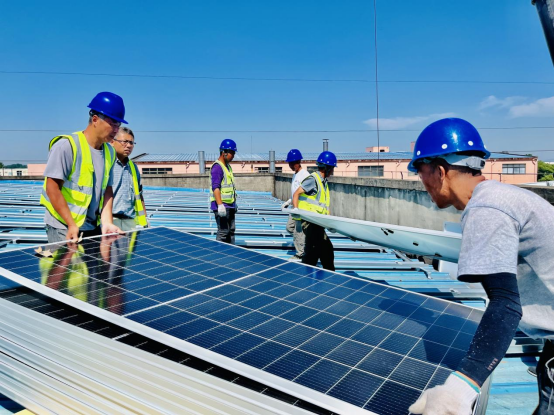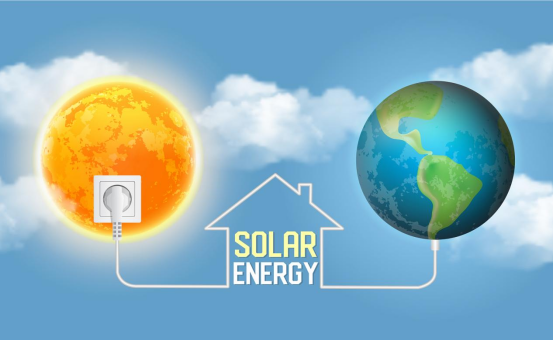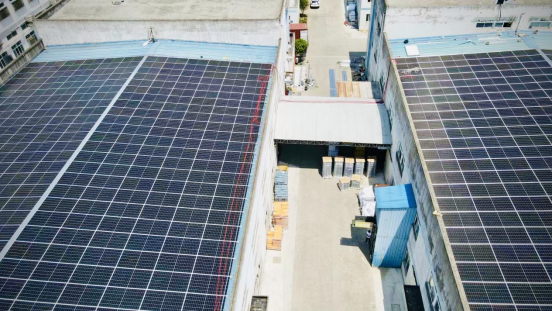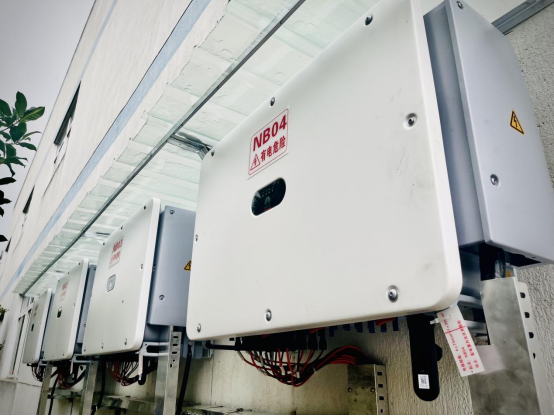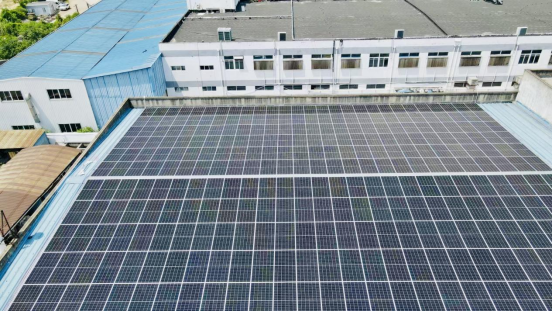Recently, Innopack® plastic container manufacturer & packaging cooperated with internationally renowned renewable energy distributor CSI Solar (China) in photovoltaic plants. This project is significant for a Chinese company. They are transitioning from producing regular plastic buckets to energy-efficient ones. This change supports sustainable development and energiewende in injection molding manufacturing.
One fact that most people may not know, injection molding machines can cause heavy electricity energy consumption. According to different size, electricity consumption of one injection molding machine producing 5 gal buckets hourly can reach approximately 20 KW/h. How to save energy and reduce gas emission and limit carbon foot becomes one of biggest challenge
Building Integrated Photovoltaic
The Innopack® plastic container manufacturer in Suzhou, China has complete a rooftop solar project today. The project totally uses 670 Canadian photovoltaic panels which is 2010 m²roof areas.
This is a successful building integrated construction, it allows to utilize roof spaces area that rarely can be used in industrial activities, and saves more extra space than built traditional electric generator.
The building A and building B’s rooftop photovoltaic project connects to the grid as a photovoltaic grid-connected system. Innopack® has a yearly capacity of 650,000 KWH.
This BIPV program helps the workshop be more efficient with resources utilization. This clean energy power station has over 445kW capacity and generates 650,000 KWH annually. It helps to reduces 600 tons of carbon dioxide emissions each year, providing economic and environmental benefits.
Innopack® founded the plastic buckets & pails manufacturing company in 1997 and is a leader in the industry. They focus on promoting environmental protection, improving product quality, and meeting high standards for green and sustainable practices.
Innopack® has chosen clean energy for the increasing global commercial and household plastic buckets market demands. The energy upgrade focuses on improving producing capacity, injection molding performance, packaging appearance, and on time delivery worldwide. This relies on excellent green power generation to provide maximum value for customers.
What is Photovoltaic Power:
Solar photovoltaic power production is a cutting-edge technology that uses solar power to directly transform light energy into commercial electricity. The photovoltaic power production
system is generally organized of photovoltaic cells. it causes electrons to shift from one section of the panel to another when the sunlight strike on photovoltaic panels. This capture process is generating electricity which is called photovoltaic power.
The advantages of using photovoltaic power:
These photovoltaic panels’ series and parallel connections allow for the direct power supply or electrical energy storage. We can see six advantages of solar photovoltaic power plants are shown below:
- Renewable resources: Solar energy is anature gift, inexhaustible and renewable resource with wide-using in applications.
- Environmental friendly:It is clean energy because it doesn’t produce harmful pollutants like carbon dioxide or nitrogen oxides. It helps reduce greenhouse gas emissions and other air pollution due to traditional electric production .
- Low maintenance costs:Solar photovoltaic systems typically have long service lives which is more than 25 years and relatively low maintenance costs.
- Distributed power generation:Implementing solar photovoltaic power generation in various locations reduces transmission losses and grid pressure.
- Various applications: Solar photovoltaic power generation finds wide-ranging applications based on demand in residential, commercial, and industrial sectors.
- Easy installation: Unlike nuclear generation, Hydroelectric stations, or wind driver generators, Innopack®spent 20 days completing a building integrated photovoltaic plants at 670 pieces 22,333 square feet roof.
Although it has numerous advantages, solar photovoltaic power generation faces challenges such as higher costs and reduced electricity production during nighttime or rainy weather days. As technology and industry progress, solar energy generators will keep improving and play a key role in clean energy in injection molding manufacturers.
Does rooftop photovoltaic power generation have radiation?
The answer is no, there is no radiation occurs in the production of electric energy from rooftop photovoltaic plants. Photovoltaic power plants can transmit and convert solar light ray into direct
current energy via semiconductors. Afterward, it changes direct current to alternating current (AC) using an inverter.
This allows people to use electricity without any chemical changes or nuclear reactions. Hence, a roof photovoltaic power generation will not have radiation.
How Does Photovoltaic Generator Work?
The process starts with the creation of a solar cell. Solar cells are incredibly thin slices, typically made of silicon, because of its excellent electrical conductivity. Silicon atoms contain protons, electrons, and neutrons.
Protons have a positive charge and remain relatively stationary, while electrons have a negative charge and are quite dynamic. A perfect illustration is lightning, where electrons travel at light speed between clouds and the ground.
Manufacturers make solar cells using two layers of silicon with different atomic structures. The internal photovoltaic cells will capture the solar photons though the above silicon layer, it happens when the sun ray shoot on panels . This triggers a rapid movement of electrons which subsequently “liberates” the electrons from the atoms.
These captured electrons will move towards the bottom of the solar cell where they will find the positively charged protons. When connected to a load, electrons flow in one direction through a circuit, creating DC electricity.
Each cell in a panel connects in series to increase the panel’s voltage potential, completing the overall picture.
Modern solar panels typically have either 60 or 72 cells arranged in a rectangular shape under glass. These panels are now capable of producing over 400 kilo watts of power for distribute electricity in making your 20L plastic buckets from innopack®’s injection molding machine.
An assembly of solar panels, also known as an “matrix”, produces DC (Direct Current). However, you must need an inverter to transform this DC into AC (Alternating Current) to power factory appliances and lights.
Additionally, If the panels make extra power, the inverter can send it to the main grid for others to use. Alternatively, if a solar storage option exists, you can store this excess power in a battery.
A Booster of Plastic Buckets Manufacturing
After new 445KW photovoltaic power plants are grid-connected. it allows Innopack® to effectively make plastic buckets and packaging using additional clean energy, upgraded to increase another usable 24.6% electricity energy. The new photovoltaic power station will avoid suspending production because of excess power consumption. It provide stable and assistance wholesale safe and durable heavy duty plastic and metal containers in different sizes all over the world.
Innopack® makes plastic containers in various colors and sizes, from 1 gallon to 300 gallons, at their workshop. Over 30 injection molding machines run day and night to meet customer
demands and fulfill orders quickly. From now on, They use a lot of clean energy to ensure better timely delivery and product quality. This newly built photovoltaic plants helps the Innopack® plastic buckets manufacturer satisfy customer’s producing and packaging demands worldwide.

